Comprehensive System Analysis Report: Yachts Australia Online Business
VerifiedAdded on 2023/06/07
|12
|1334
|474
Report
AI Summary
This report presents a comprehensive system analysis of Yachts Australia (YA), a company seeking to automate its business processes. The analysis includes a feasibility study, addressing both technical and organizational aspects, and defines functional and non-functional requirements. The report utilizes a use case diagram to illustrate YA's processes, along with process models comprising context diagrams, level 0 and level 1 data flow diagrams. A detailed data model is also provided, featuring a data dictionary and an entity relationship diagram, to represent the business processes effectively. The report covers various aspects of the business including booking, payments, and discounts, and aims to provide a structured approach to automate the business.
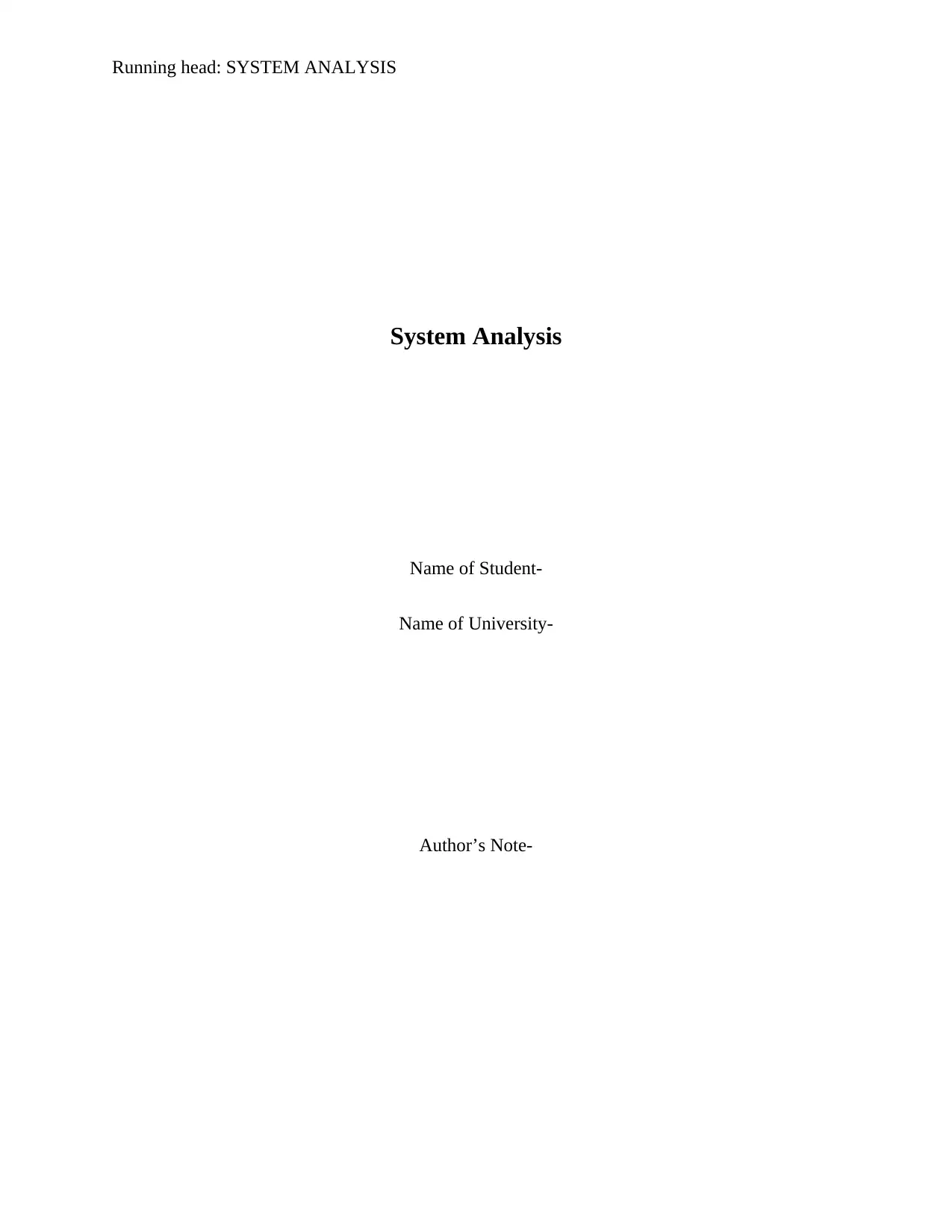
Running head: SYSTEM ANALYSIS
System Analysis
Name of Student-
Name of University-
Author’s Note-
System Analysis
Name of Student-
Name of University-
Author’s Note-
Paraphrase This Document
Need a fresh take? Get an instant paraphrase of this document with our AI Paraphraser
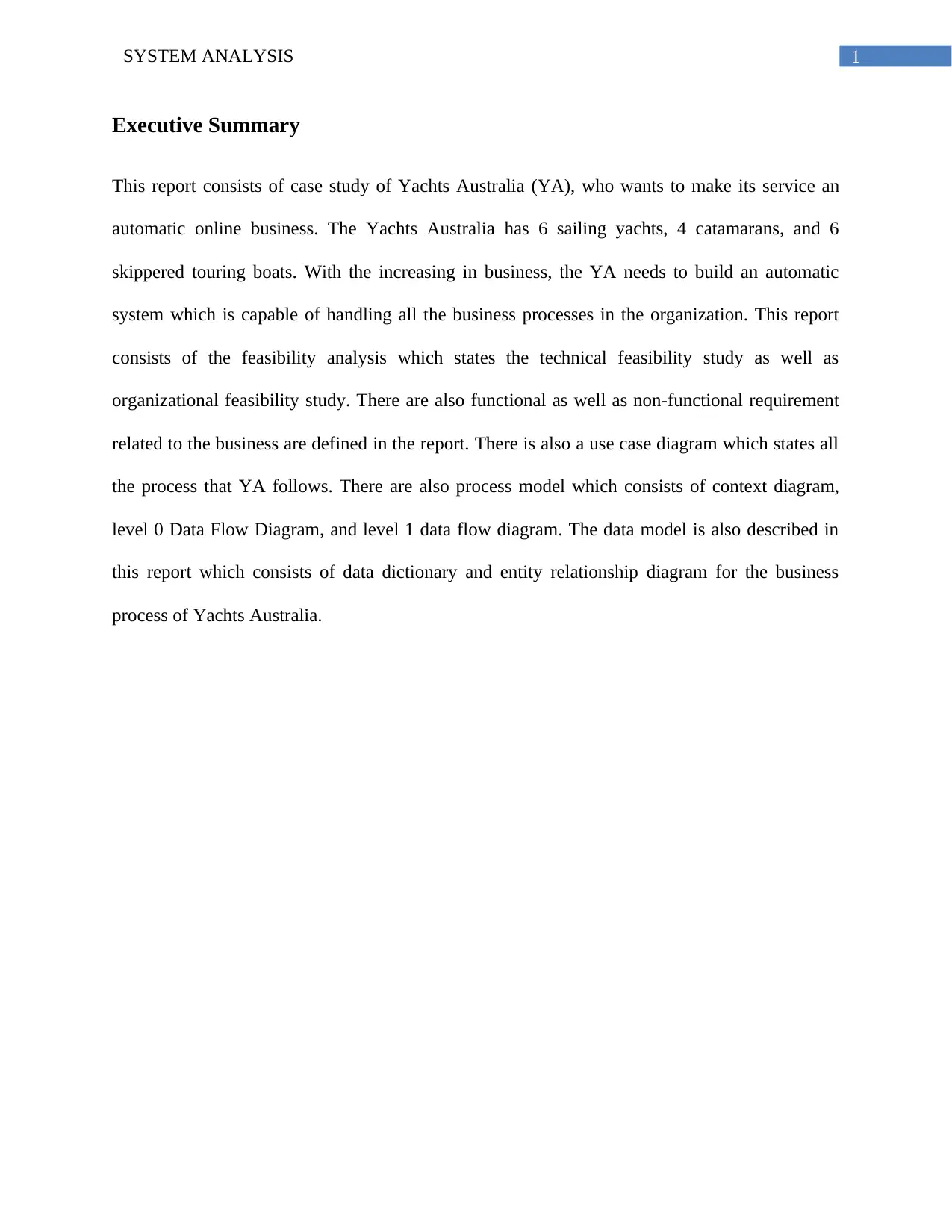
1SYSTEM ANALYSIS
Executive Summary
This report consists of case study of Yachts Australia (YA), who wants to make its service an
automatic online business. The Yachts Australia has 6 sailing yachts, 4 catamarans, and 6
skippered touring boats. With the increasing in business, the YA needs to build an automatic
system which is capable of handling all the business processes in the organization. This report
consists of the feasibility analysis which states the technical feasibility study as well as
organizational feasibility study. There are also functional as well as non-functional requirement
related to the business are defined in the report. There is also a use case diagram which states all
the process that YA follows. There are also process model which consists of context diagram,
level 0 Data Flow Diagram, and level 1 data flow diagram. The data model is also described in
this report which consists of data dictionary and entity relationship diagram for the business
process of Yachts Australia.
Executive Summary
This report consists of case study of Yachts Australia (YA), who wants to make its service an
automatic online business. The Yachts Australia has 6 sailing yachts, 4 catamarans, and 6
skippered touring boats. With the increasing in business, the YA needs to build an automatic
system which is capable of handling all the business processes in the organization. This report
consists of the feasibility analysis which states the technical feasibility study as well as
organizational feasibility study. There are also functional as well as non-functional requirement
related to the business are defined in the report. There is also a use case diagram which states all
the process that YA follows. There are also process model which consists of context diagram,
level 0 Data Flow Diagram, and level 1 data flow diagram. The data model is also described in
this report which consists of data dictionary and entity relationship diagram for the business
process of Yachts Australia.
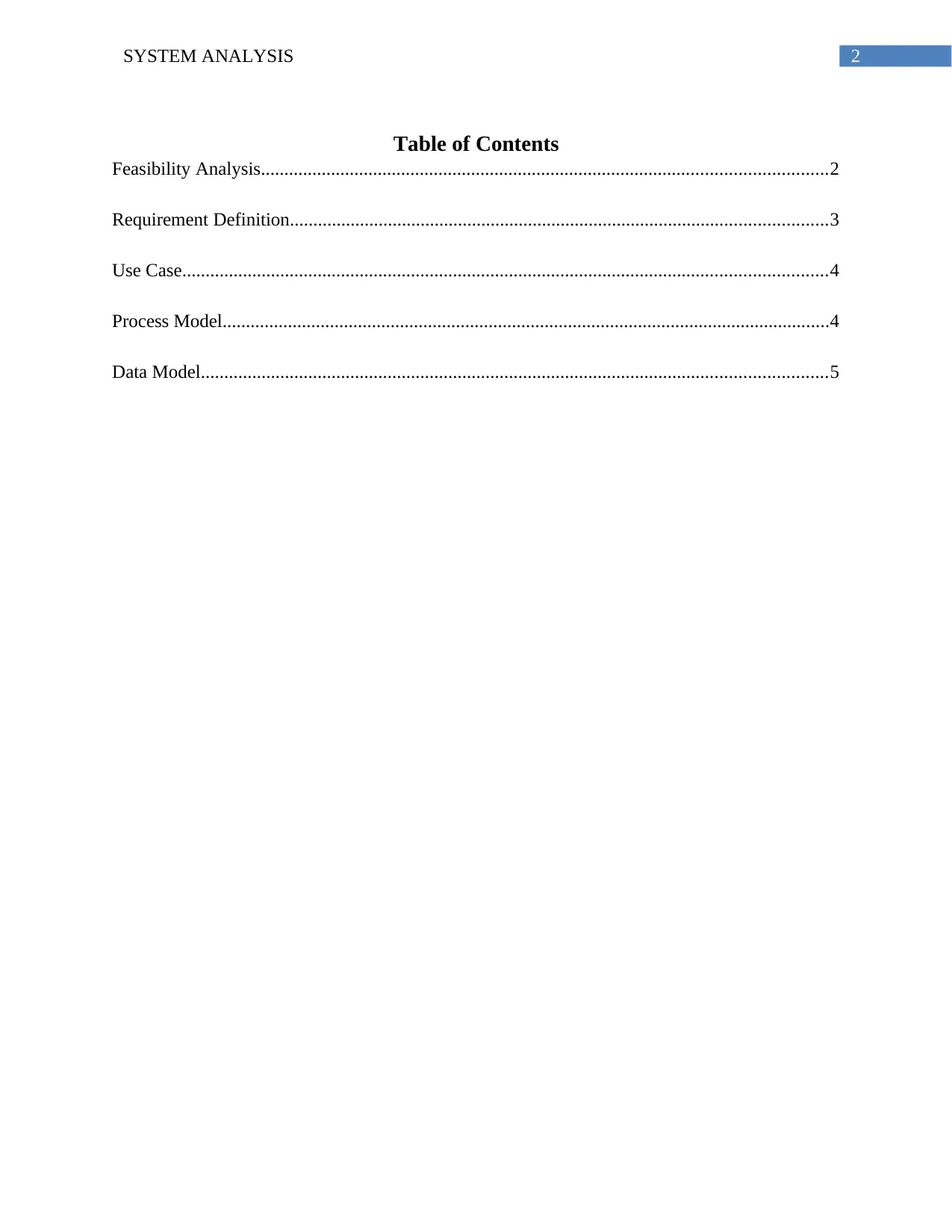
2SYSTEM ANALYSIS
Table of Contents
Feasibility Analysis.........................................................................................................................2
Requirement Definition...................................................................................................................3
Use Case..........................................................................................................................................4
Process Model..................................................................................................................................4
Data Model......................................................................................................................................5
Table of Contents
Feasibility Analysis.........................................................................................................................2
Requirement Definition...................................................................................................................3
Use Case..........................................................................................................................................4
Process Model..................................................................................................................................4
Data Model......................................................................................................................................5
⊘ This is a preview!⊘
Do you want full access?
Subscribe today to unlock all pages.

Trusted by 1+ million students worldwide
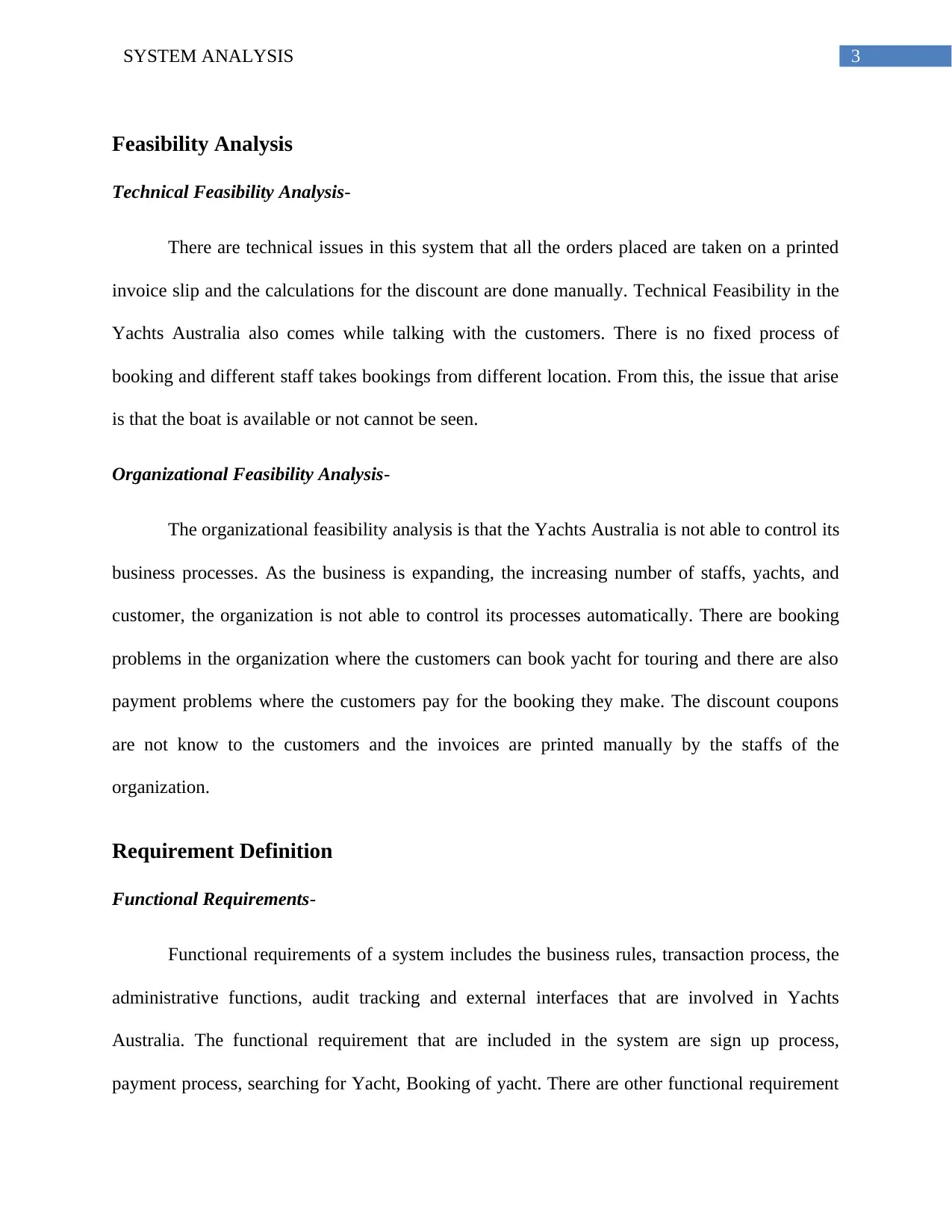
3SYSTEM ANALYSIS
Feasibility Analysis
Technical Feasibility Analysis-
There are technical issues in this system that all the orders placed are taken on a printed
invoice slip and the calculations for the discount are done manually. Technical Feasibility in the
Yachts Australia also comes while talking with the customers. There is no fixed process of
booking and different staff takes bookings from different location. From this, the issue that arise
is that the boat is available or not cannot be seen.
Organizational Feasibility Analysis-
The organizational feasibility analysis is that the Yachts Australia is not able to control its
business processes. As the business is expanding, the increasing number of staffs, yachts, and
customer, the organization is not able to control its processes automatically. There are booking
problems in the organization where the customers can book yacht for touring and there are also
payment problems where the customers pay for the booking they make. The discount coupons
are not know to the customers and the invoices are printed manually by the staffs of the
organization.
Requirement Definition
Functional Requirements-
Functional requirements of a system includes the business rules, transaction process, the
administrative functions, audit tracking and external interfaces that are involved in Yachts
Australia. The functional requirement that are included in the system are sign up process,
payment process, searching for Yacht, Booking of yacht. There are other functional requirement
Feasibility Analysis
Technical Feasibility Analysis-
There are technical issues in this system that all the orders placed are taken on a printed
invoice slip and the calculations for the discount are done manually. Technical Feasibility in the
Yachts Australia also comes while talking with the customers. There is no fixed process of
booking and different staff takes bookings from different location. From this, the issue that arise
is that the boat is available or not cannot be seen.
Organizational Feasibility Analysis-
The organizational feasibility analysis is that the Yachts Australia is not able to control its
business processes. As the business is expanding, the increasing number of staffs, yachts, and
customer, the organization is not able to control its processes automatically. There are booking
problems in the organization where the customers can book yacht for touring and there are also
payment problems where the customers pay for the booking they make. The discount coupons
are not know to the customers and the invoices are printed manually by the staffs of the
organization.
Requirement Definition
Functional Requirements-
Functional requirements of a system includes the business rules, transaction process, the
administrative functions, audit tracking and external interfaces that are involved in Yachts
Australia. The functional requirement that are included in the system are sign up process,
payment process, searching for Yacht, Booking of yacht. There are other functional requirement
Paraphrase This Document
Need a fresh take? Get an instant paraphrase of this document with our AI Paraphraser
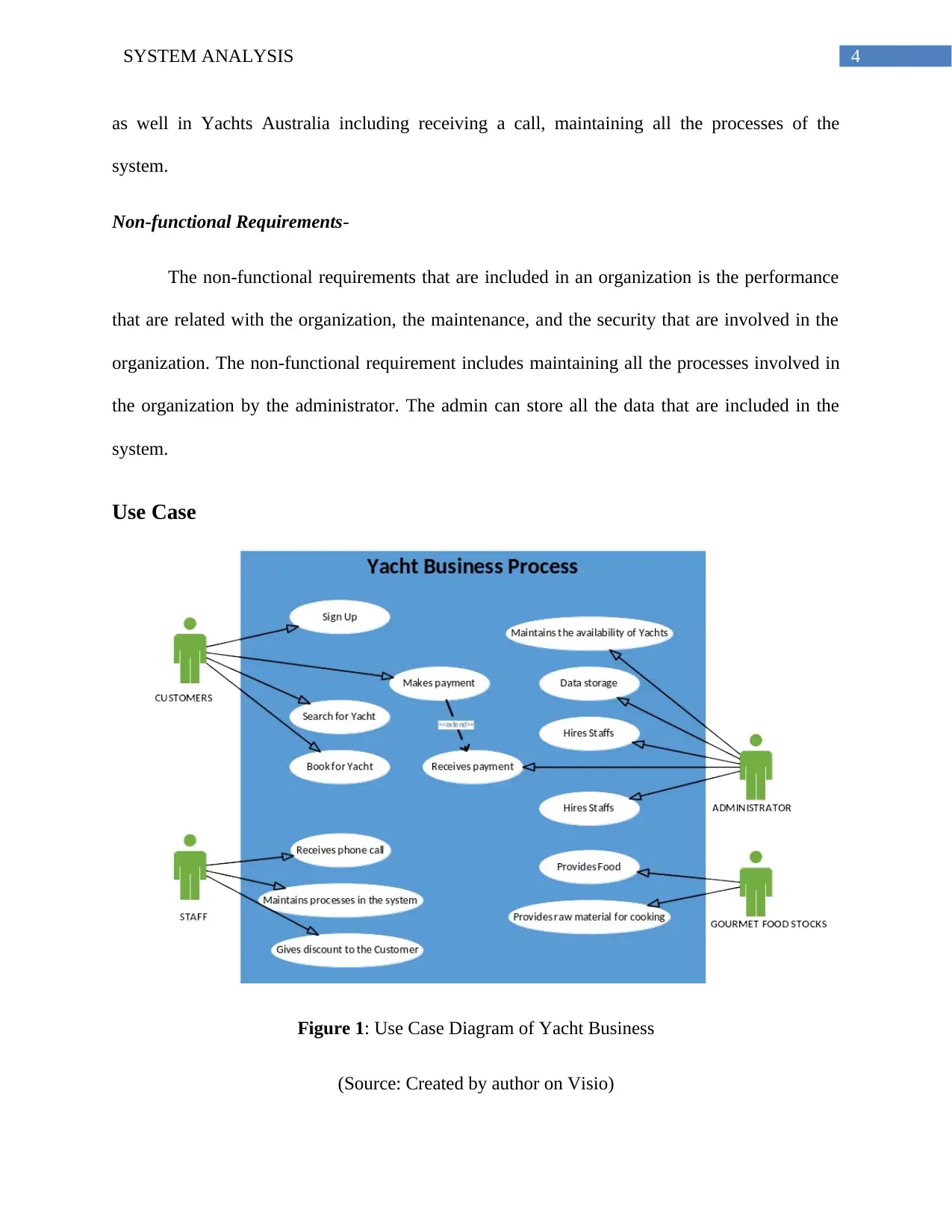
4SYSTEM ANALYSIS
as well in Yachts Australia including receiving a call, maintaining all the processes of the
system.
Non-functional Requirements-
The non-functional requirements that are included in an organization is the performance
that are related with the organization, the maintenance, and the security that are involved in the
organization. The non-functional requirement includes maintaining all the processes involved in
the organization by the administrator. The admin can store all the data that are included in the
system.
Use Case
Figure 1: Use Case Diagram of Yacht Business
(Source: Created by author on Visio)
as well in Yachts Australia including receiving a call, maintaining all the processes of the
system.
Non-functional Requirements-
The non-functional requirements that are included in an organization is the performance
that are related with the organization, the maintenance, and the security that are involved in the
organization. The non-functional requirement includes maintaining all the processes involved in
the organization by the administrator. The admin can store all the data that are included in the
system.
Use Case
Figure 1: Use Case Diagram of Yacht Business
(Source: Created by author on Visio)
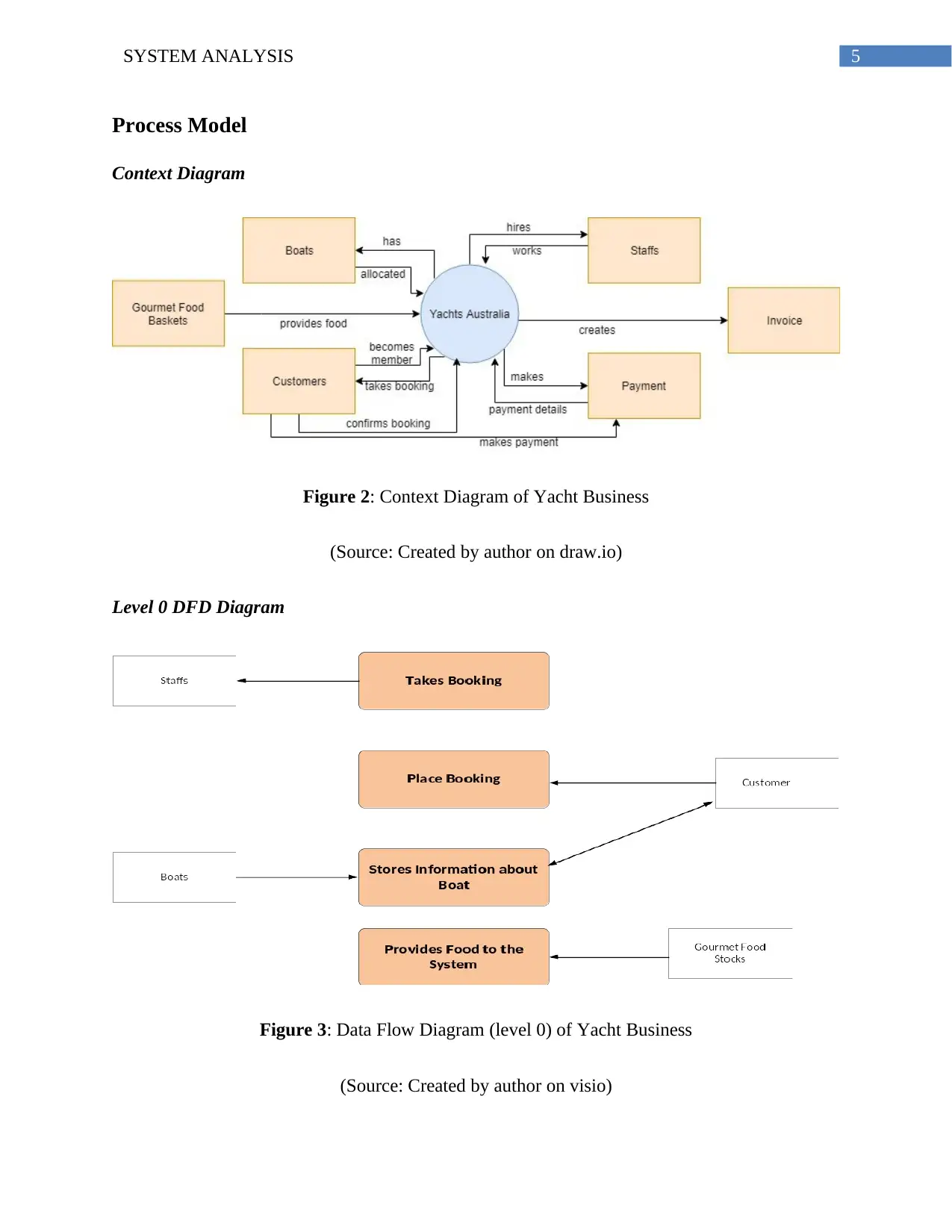
5SYSTEM ANALYSIS
Process Model
Context Diagram
Figure 2: Context Diagram of Yacht Business
(Source: Created by author on draw.io)
Level 0 DFD Diagram
Figure 3: Data Flow Diagram (level 0) of Yacht Business
(Source: Created by author on visio)
Process Model
Context Diagram
Figure 2: Context Diagram of Yacht Business
(Source: Created by author on draw.io)
Level 0 DFD Diagram
Figure 3: Data Flow Diagram (level 0) of Yacht Business
(Source: Created by author on visio)
⊘ This is a preview!⊘
Do you want full access?
Subscribe today to unlock all pages.

Trusted by 1+ million students worldwide
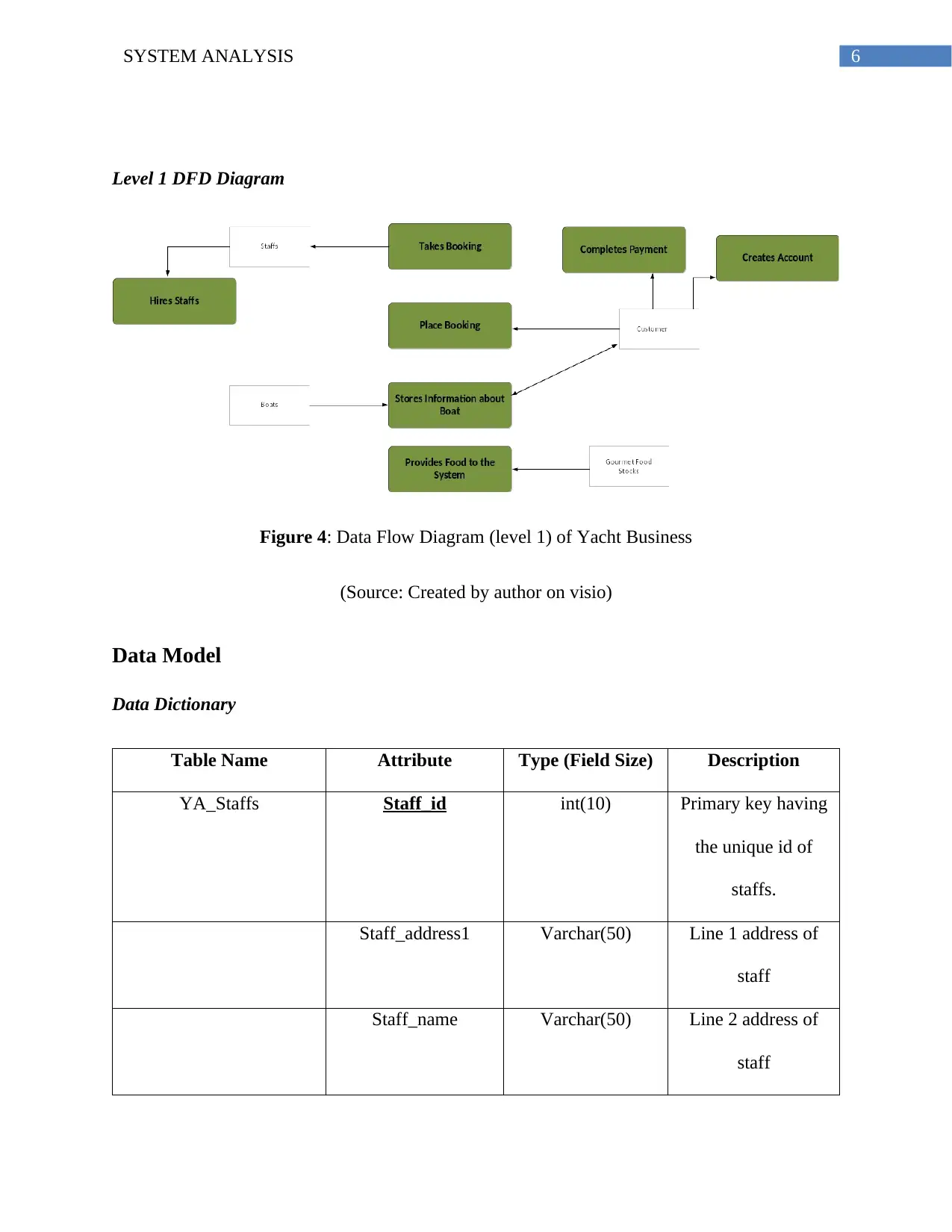
6SYSTEM ANALYSIS
Level 1 DFD Diagram
Figure 4: Data Flow Diagram (level 1) of Yacht Business
(Source: Created by author on visio)
Data Model
Data Dictionary
Table Name Attribute Type (Field Size) Description
YA_Staffs Staff_id int(10) Primary key having
the unique id of
staffs.
Staff_address1 Varchar(50) Line 1 address of
staff
Staff_name Varchar(50) Line 2 address of
staff
Level 1 DFD Diagram
Figure 4: Data Flow Diagram (level 1) of Yacht Business
(Source: Created by author on visio)
Data Model
Data Dictionary
Table Name Attribute Type (Field Size) Description
YA_Staffs Staff_id int(10) Primary key having
the unique id of
staffs.
Staff_address1 Varchar(50) Line 1 address of
staff
Staff_name Varchar(50) Line 2 address of
staff
Paraphrase This Document
Need a fresh take? Get an instant paraphrase of this document with our AI Paraphraser
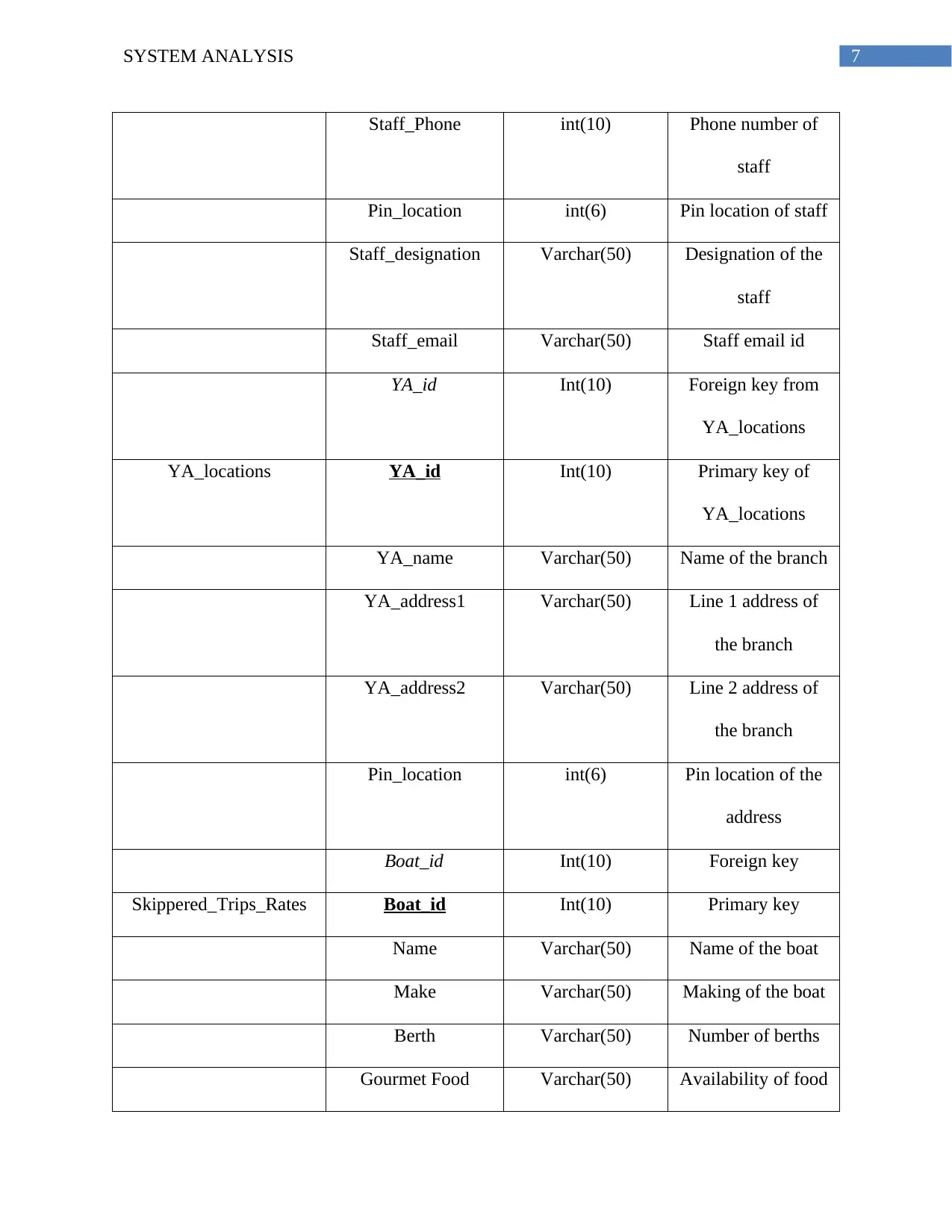
7SYSTEM ANALYSIS
Staff_Phone int(10) Phone number of
staff
Pin_location int(6) Pin location of staff
Staff_designation Varchar(50) Designation of the
staff
Staff_email Varchar(50) Staff email id
YA_id Int(10) Foreign key from
YA_locations
YA_locations YA_id Int(10) Primary key of
YA_locations
YA_name Varchar(50) Name of the branch
YA_address1 Varchar(50) Line 1 address of
the branch
YA_address2 Varchar(50) Line 2 address of
the branch
Pin_location int(6) Pin location of the
address
Boat_id Int(10) Foreign key
Skippered_Trips_Rates Boat_id Int(10) Primary key
Name Varchar(50) Name of the boat
Make Varchar(50) Making of the boat
Berth Varchar(50) Number of berths
Gourmet Food Varchar(50) Availability of food
Staff_Phone int(10) Phone number of
staff
Pin_location int(6) Pin location of staff
Staff_designation Varchar(50) Designation of the
staff
Staff_email Varchar(50) Staff email id
YA_id Int(10) Foreign key from
YA_locations
YA_locations YA_id Int(10) Primary key of
YA_locations
YA_name Varchar(50) Name of the branch
YA_address1 Varchar(50) Line 1 address of
the branch
YA_address2 Varchar(50) Line 2 address of
the branch
Pin_location int(6) Pin location of the
address
Boat_id Int(10) Foreign key
Skippered_Trips_Rates Boat_id Int(10) Primary key
Name Varchar(50) Name of the boat
Make Varchar(50) Making of the boat
Berth Varchar(50) Number of berths
Gourmet Food Varchar(50) Availability of food
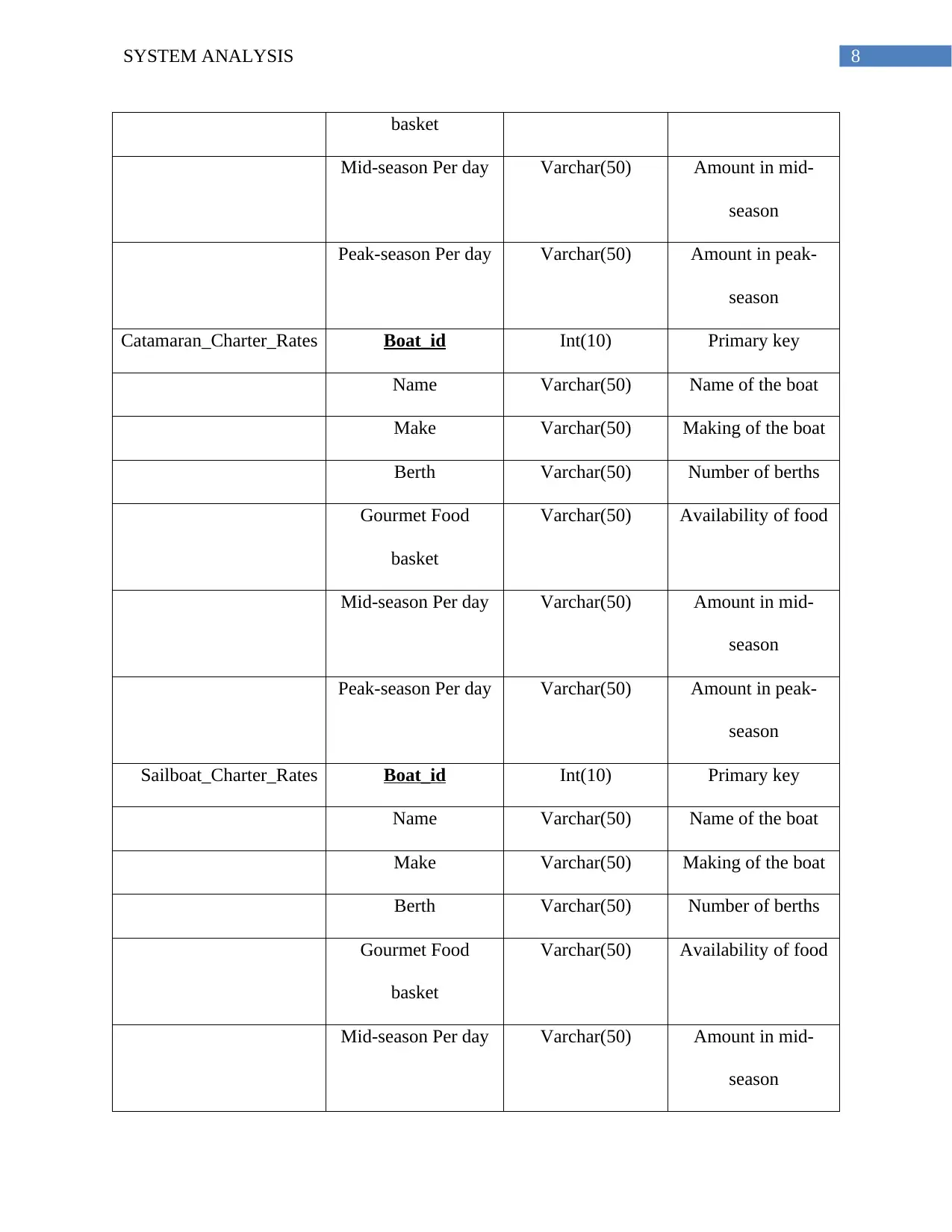
8SYSTEM ANALYSIS
basket
Mid-season Per day Varchar(50) Amount in mid-
season
Peak-season Per day Varchar(50) Amount in peak-
season
Catamaran_Charter_Rates Boat_id Int(10) Primary key
Name Varchar(50) Name of the boat
Make Varchar(50) Making of the boat
Berth Varchar(50) Number of berths
Gourmet Food
basket
Varchar(50) Availability of food
Mid-season Per day Varchar(50) Amount in mid-
season
Peak-season Per day Varchar(50) Amount in peak-
season
Sailboat_Charter_Rates Boat_id Int(10) Primary key
Name Varchar(50) Name of the boat
Make Varchar(50) Making of the boat
Berth Varchar(50) Number of berths
Gourmet Food
basket
Varchar(50) Availability of food
Mid-season Per day Varchar(50) Amount in mid-
season
basket
Mid-season Per day Varchar(50) Amount in mid-
season
Peak-season Per day Varchar(50) Amount in peak-
season
Catamaran_Charter_Rates Boat_id Int(10) Primary key
Name Varchar(50) Name of the boat
Make Varchar(50) Making of the boat
Berth Varchar(50) Number of berths
Gourmet Food
basket
Varchar(50) Availability of food
Mid-season Per day Varchar(50) Amount in mid-
season
Peak-season Per day Varchar(50) Amount in peak-
season
Sailboat_Charter_Rates Boat_id Int(10) Primary key
Name Varchar(50) Name of the boat
Make Varchar(50) Making of the boat
Berth Varchar(50) Number of berths
Gourmet Food
basket
Varchar(50) Availability of food
Mid-season Per day Varchar(50) Amount in mid-
season
⊘ This is a preview!⊘
Do you want full access?
Subscribe today to unlock all pages.

Trusted by 1+ million students worldwide
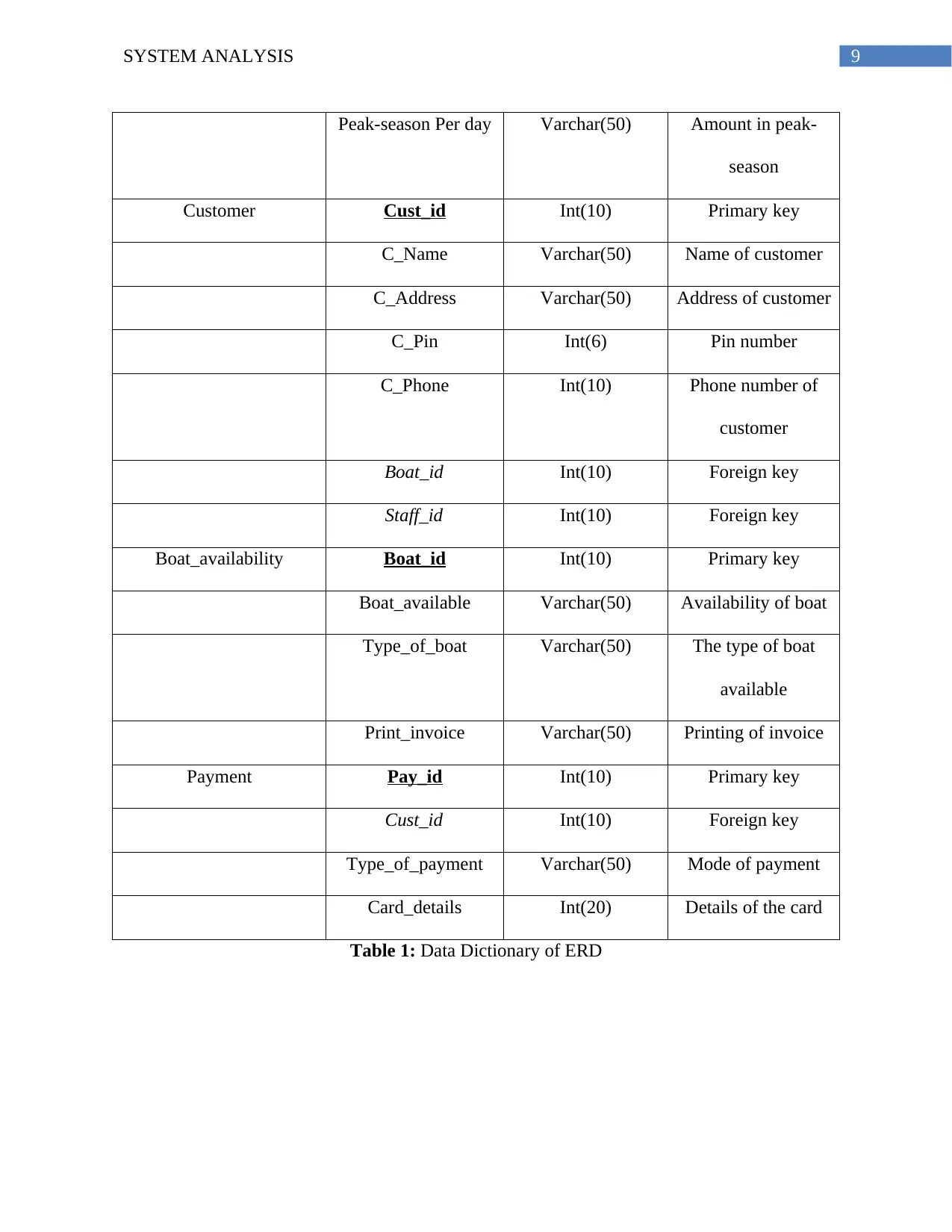
9SYSTEM ANALYSIS
Peak-season Per day Varchar(50) Amount in peak-
season
Customer Cust_id Int(10) Primary key
C_Name Varchar(50) Name of customer
C_Address Varchar(50) Address of customer
C_Pin Int(6) Pin number
C_Phone Int(10) Phone number of
customer
Boat_id Int(10) Foreign key
Staff_id Int(10) Foreign key
Boat_availability Boat_id Int(10) Primary key
Boat_available Varchar(50) Availability of boat
Type_of_boat Varchar(50) The type of boat
available
Print_invoice Varchar(50) Printing of invoice
Payment Pay_id Int(10) Primary key
Cust_id Int(10) Foreign key
Type_of_payment Varchar(50) Mode of payment
Card_details Int(20) Details of the card
Table 1: Data Dictionary of ERD
Peak-season Per day Varchar(50) Amount in peak-
season
Customer Cust_id Int(10) Primary key
C_Name Varchar(50) Name of customer
C_Address Varchar(50) Address of customer
C_Pin Int(6) Pin number
C_Phone Int(10) Phone number of
customer
Boat_id Int(10) Foreign key
Staff_id Int(10) Foreign key
Boat_availability Boat_id Int(10) Primary key
Boat_available Varchar(50) Availability of boat
Type_of_boat Varchar(50) The type of boat
available
Print_invoice Varchar(50) Printing of invoice
Payment Pay_id Int(10) Primary key
Cust_id Int(10) Foreign key
Type_of_payment Varchar(50) Mode of payment
Card_details Int(20) Details of the card
Table 1: Data Dictionary of ERD
Paraphrase This Document
Need a fresh take? Get an instant paraphrase of this document with our AI Paraphraser
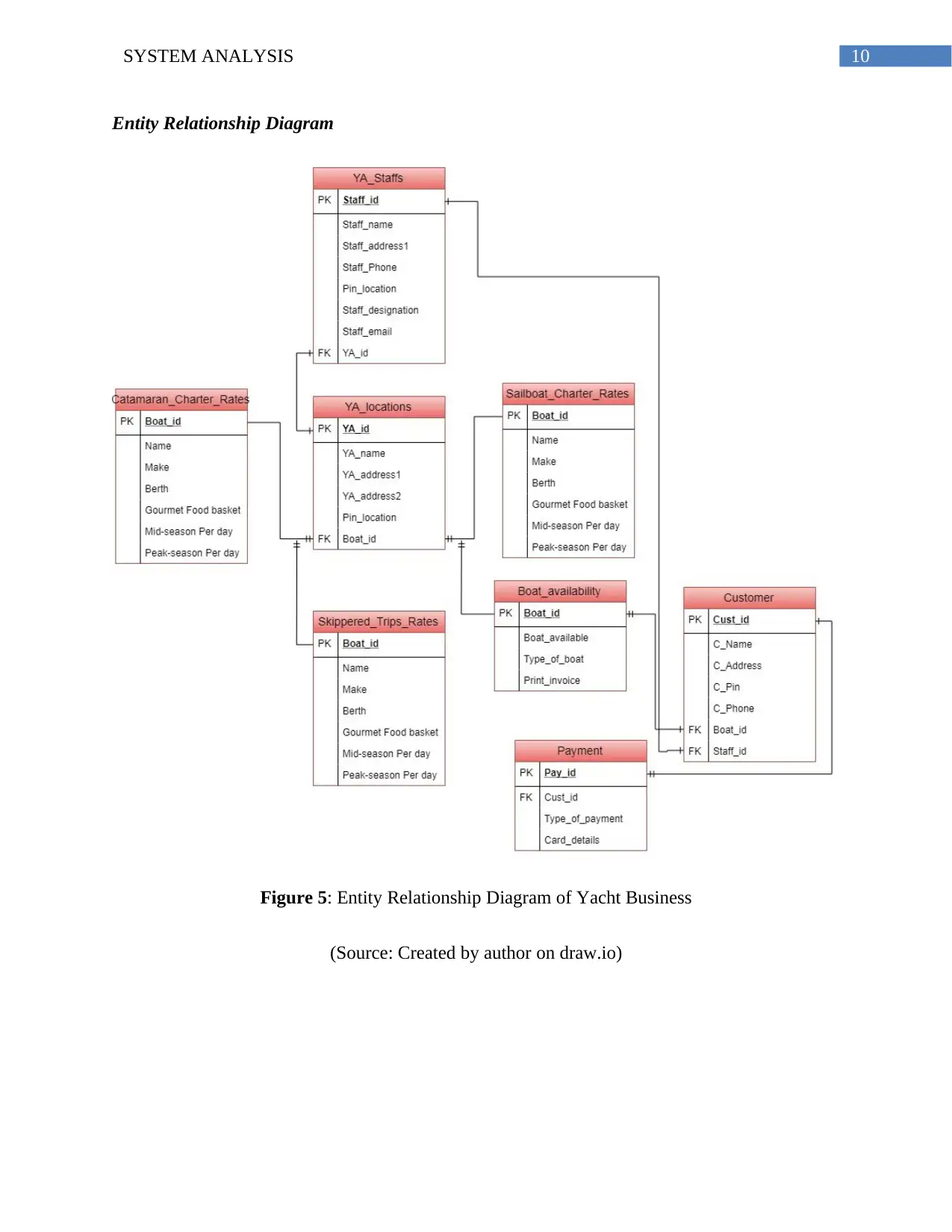
10SYSTEM ANALYSIS
Entity Relationship Diagram
Figure 5: Entity Relationship Diagram of Yacht Business
(Source: Created by author on draw.io)
Entity Relationship Diagram
Figure 5: Entity Relationship Diagram of Yacht Business
(Source: Created by author on draw.io)
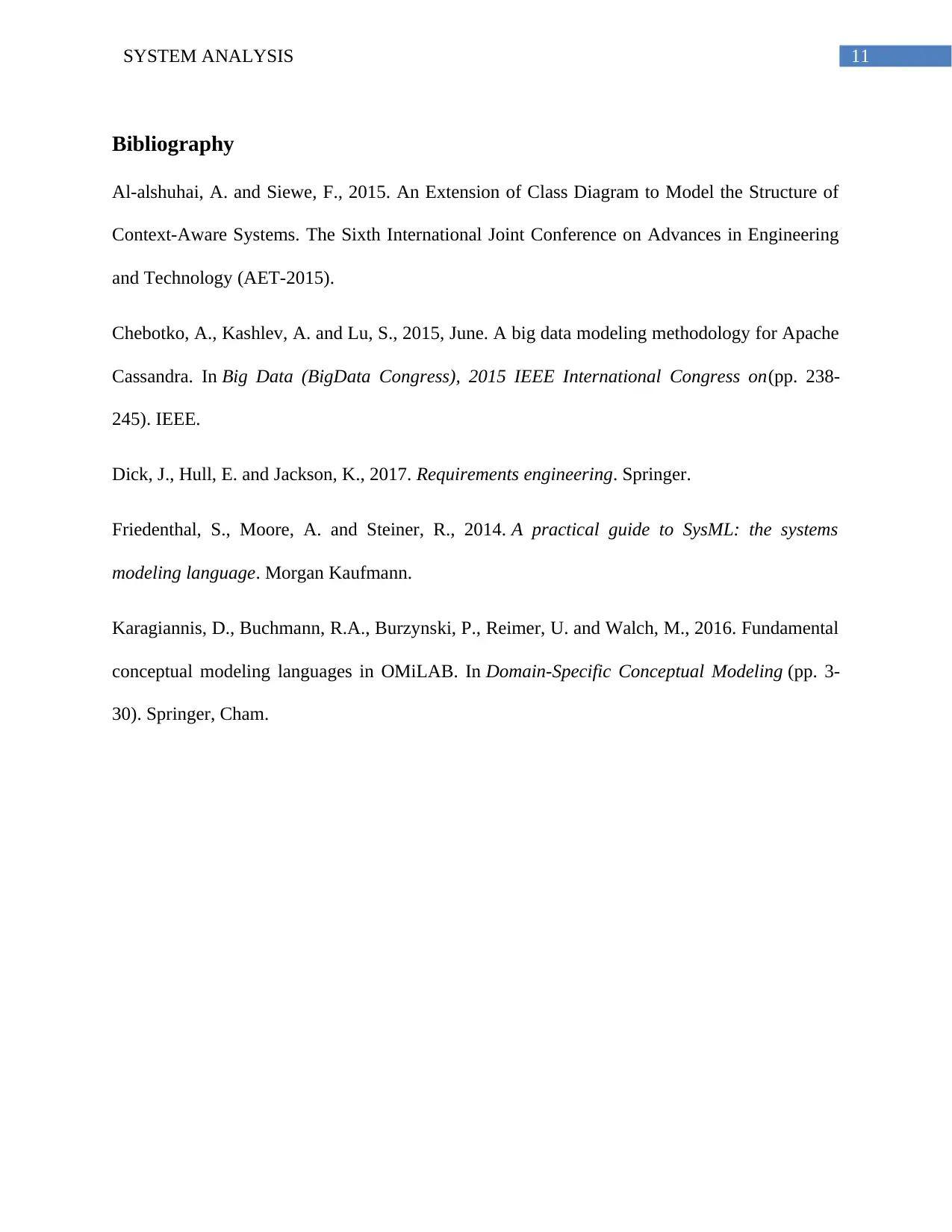
11SYSTEM ANALYSIS
Bibliography
Al-alshuhai, A. and Siewe, F., 2015. An Extension of Class Diagram to Model the Structure of
Context-Aware Systems. The Sixth International Joint Conference on Advances in Engineering
and Technology (AET-2015).
Chebotko, A., Kashlev, A. and Lu, S., 2015, June. A big data modeling methodology for Apache
Cassandra. In Big Data (BigData Congress), 2015 IEEE International Congress on(pp. 238-
245). IEEE.
Dick, J., Hull, E. and Jackson, K., 2017. Requirements engineering. Springer.
Friedenthal, S., Moore, A. and Steiner, R., 2014. A practical guide to SysML: the systems
modeling language. Morgan Kaufmann.
Karagiannis, D., Buchmann, R.A., Burzynski, P., Reimer, U. and Walch, M., 2016. Fundamental
conceptual modeling languages in OMiLAB. In Domain-Specific Conceptual Modeling (pp. 3-
30). Springer, Cham.
Bibliography
Al-alshuhai, A. and Siewe, F., 2015. An Extension of Class Diagram to Model the Structure of
Context-Aware Systems. The Sixth International Joint Conference on Advances in Engineering
and Technology (AET-2015).
Chebotko, A., Kashlev, A. and Lu, S., 2015, June. A big data modeling methodology for Apache
Cassandra. In Big Data (BigData Congress), 2015 IEEE International Congress on(pp. 238-
245). IEEE.
Dick, J., Hull, E. and Jackson, K., 2017. Requirements engineering. Springer.
Friedenthal, S., Moore, A. and Steiner, R., 2014. A practical guide to SysML: the systems
modeling language. Morgan Kaufmann.
Karagiannis, D., Buchmann, R.A., Burzynski, P., Reimer, U. and Walch, M., 2016. Fundamental
conceptual modeling languages in OMiLAB. In Domain-Specific Conceptual Modeling (pp. 3-
30). Springer, Cham.
⊘ This is a preview!⊘
Do you want full access?
Subscribe today to unlock all pages.

Trusted by 1+ million students worldwide
1 out of 12
Related Documents
Your All-in-One AI-Powered Toolkit for Academic Success.
+13062052269
info@desklib.com
Available 24*7 on WhatsApp / Email
![[object Object]](/_next/static/media/star-bottom.7253800d.svg)
Unlock your academic potential
Copyright © 2020–2025 A2Z Services. All Rights Reserved. Developed and managed by ZUCOL.





